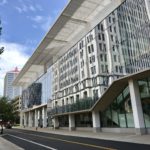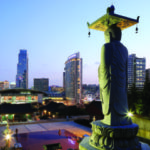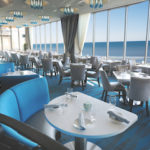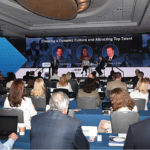The capital and second-largest city of the United Arab Emirates (UAE) is a safe, modern, and perennially sunny spot on the Arabian Gulf that has embarked on an ambitious plan to transform itself into a global business destination — with the Abu Dhabi National Exhibitions Company (ADNEC), the government-owned entity that operates the Abu Dhabi National Exhibition Centre, actively courting North American meeting professionals. As part of this effort, ADNEC hosted Convene for a three-day trip in January to experience its state-of-the-art venue, modern-day Arabian hospitality, and all the gold-encrusted extravagance that one of the richest cities in the world has to offer.
One of the biggest marketing challenges facing ADNEC, according to CEO Pieter Idenburg, is the fact that many North Americans aren’t sure where Abu Dhabi is. The answer: as far as it seems, but closer than you think. The Abu Dhabi International Airport is served by 53 airlines and easily accessed from 85 destinations in 49 countries. A nonstop, 14-hour flight on Etihad, the emirate’s national airline, brought me directly from Chicago to the new, spotlessly clean, and very efficient Abu Dhabi International Airport.
From there, it was a 20-minute car ride to the Capital Centre district and ADNEC. Despite the 10-hour time difference and some jet lag, it didn’t take long to get comfortable in my hotel, the five-star Hyatt Capital Gate. A sleek, contemporary building that holds the distinction of being the world’s furthest-leaning man-made tower — tipping a dramatic 18 degrees — the 189-room Hyatt Capital Gate is the most luxurious of the five hotels located at Capital Centre, which together offer more than 1,500 rooms.
I spent the first two days of my trip attending the World Future Energy Summit (WFES) 2013, a large, global event that was a dramatic showcase for ADNEC’s space and versatility. The 785,480-square-foot, state-of-the-art facility is the largest exhibition venue in the Middle East, with 12 interconnected exhibit halls totaling 180,500 square feet — nearly all of it utilized by WFES. (Look for an in-depth report on WFES in next month’s issue.)
During my visit, I enjoyed several delicious Middle Eastern meals, including lunch my first day at 18°, the Hyatt’s signature restaurant, which features fresh, locally sourced dishes inspired by traditional Lebanese, Greek, Syrian, and Turkish cuisine. That night, a small group of us ate at Dine, the anchor restaurant in Aloft Abu Dhabi, the edgier, less-formal four-star hotel that’s also connected to ADNEC.
For lunch on my second day, my hosts took me to Olivia’s, an Italian trattoria located within the ADNEC grandstand. Although the menu consisted mostly of standard Italian fare, we did sample the camel pizza, which tasted more strongly of the spices used to flavor the meat than anything else.
On night two, we left Capital Centre and headed through downtown (about 20 minutes) to the Abu Dhabi port area for a dinner cruise. The Al Dhafra restaurant provides event space for up to 800 people in land-side ballrooms and private dinner cruises for about 50 aboard a traditional wooden dhow sailing vessel. For several hours, our group cruised alongside the Corniche, the city’s popular beachfront, dining on a multi-course Middle Eastern feast that included hammour (a locally caught fish) and luqaimat (crispy fried dough balls).
On day three, I set out to see more of Abu Dhabi with a guide from the Abu Dhabi Tourism & Culture Authority. We began with a visit to the Sheikh Zayed Grand Mosque, a magnificent, white-marble tribute to the founder and first president of the UAE. Completed in 2007, it is the third-largest mosque in the world and the most-visited site in Abu Dhabi. It can accommodate more than 40,000 worshippers and features the world’s largest hand-knotted carpet and seven gold and crystal chandeliers (lit with LED lights, for a modern twist).
Just five minutes from the mosque is the soon-to-be-opened Ritz-Carlton Abu Dhabi, Grand Canal. With dramatic views of the mosque on one side and waterfront views on the other, the 532-room hotel provides another luxury option close to ADNEC. It is the first Ritz property in Abu Dhabi, with three signature restaurants, private villas, and 23,484 square feet of event space.
From the Ritz, we headed to the city center and the opulent Emirates Palace, known for its gold-dusted cappuccino and gold-bar-dispensing ATM. The hotel is a top tourist site, but also includes 394 guest rooms and suites and conference facilities. We toured the auditorium and a 2,400-person ballroom, as well as a decadent suite that is available for $15,000 per night.
A mere 15 minutes from Emirates Palaces — but a world away — is the beachfront Park Hyatt Abu Dhabi on Saadiyat Island. (Abu Dhabi city is actually an island, and the emirate is made up of 200 natural islands, one of which is Saadiyat.) Saadiyat is currently a quiet resort area with protected whites and beaches, high-end hotels, and golf courses, but soon it will be the site of Cultural District, the world’s largest concentration of premier cultural institutions, including the Louvre Abu Dhabi, the Guggenheim Abu Dhabi Museum, the Sheikh Zayed National Museum, and a performing-arts center.
Picking up the pace (literally), our last stop was the Yas Marina Circuit on nearby Yas Island. Home to the Formula 1 Etihad Airways Abu Dhabi Grand Prix, the track offers planners a unique venue for a variety of events, including trackside team-building exercises and a racing school.



